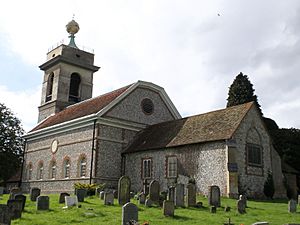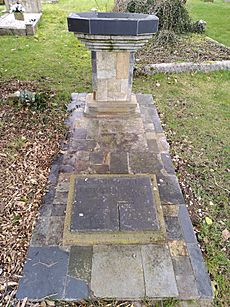St Lawrence's Church, West Wycombe facts for kids
Quick facts for kids St Lawrence Church, West Wycombe |
|
|---|---|
| The Church of St Lawrence, West Wycombe | |

The church as it looked in 2009.
|
|
| 51°38′50″N 0°48′20″W / 51.647154°N 0.805624°W | |
| Location | West Wycombe |
| Country | England |
| Denomination | Church of England |
| History | |
| Dedication | St Lawrence |
| Architecture | |
| Heritage designation | Grade I listed church |
| Designated | 9 January 1954 |
| Architect(s) | Widely believed John Donowell |
| Architectural type | Mixed, medieval and neoclassical |
| Style | Classical and Rococo |
| Completed | 3 July 1763 |
| Specifications | |
| Materials | Flint, stone, masonry, marble, painted frescoes, gilt |
| Bells | 8 |
| Administration | |
| Parish | West Wycombe Parish |
| Deanery | Wycombe Deanery |
| Diocese | Diocese of Oxford |
St Lawrence Church is a famous Church of England church located in West Wycombe, Buckinghamshire, England. It stands on top of West Wycombe Hill, offering amazing views of the surrounding villages and countryside. The hill is looked after by the National Trust, but the church and its graveyard belong to the Church of England.
The church is easy to spot from far away because of its tall tower, which is topped by a large golden ball. The top of the tower is the highest point in the southern part of the Chiltern Hills. On a clear day, you can even see parts of West London from there.
Contents
History of the Church
From Medieval Times to a Grand Redesign
The story of St Lawrence Church begins in the Middle Ages. The oldest parts of the church that still exist today are the chancel (the area around the altar) and the tower, which were built in the 14th century.
In the 1700s, the church was completely transformed by a man named Sir Francis Dashwood. He wanted to make the church a stunning landmark that could be seen from his home, West Wycombe Park. In the 1750s, he made the tower much taller and added the famous golden ball on top. It is said he got the idea for the ball from a building in Venice, Italy.
Between 1761 and 1763, the main part of the church, called the nave, was rebuilt. The old chancel was also given a new look. The person who likely designed these changes was the architect John Donowell.
A Secretive Club and a Hidden Message
The golden ball on the tower is hollow and has benches inside. It was rumored to be a meeting spot for a famous and secretive group that Sir Francis Dashwood belonged to. One member, the writer John Wilkes, once joked that the ball was "the best globe tavern I was ever in."
There is also a story that Sir Francis Dashwood used the golden ball to send signals. He might have used a heliograph, a device that reflects sunlight, to flash messages from a small window in the ball to his friend, John Norris (1721–1786). Norris lived 21 miles away and had built his own tower, now called the Camberley Obelisk.
A Look Inside the Church
The inside of the church is just as impressive as the outside. Sir Francis Dashwood wanted the nave to look like a grand hall from an ancient Roman temple.
Amazing Art and Design
The nave was designed based on pictures of the ancient Temple of the Sun in Palmyra, a historic city in modern-day Syria. It has tall columns that are decorated to look like a type of purple marble called porphyry.
The church is famous for its Trompe-l'œil paintings, which is a French term for "trick of the eye." These paintings are so realistic they can fool you into thinking they are three-dimensional objects. The ceiling in the nave is a beautiful example of this style. In the chancel, there is a large painting of the Last Supper, which was inspired by a famous work by the artist Rembrandt. All of these amazing paintings were created by an artist named Giovanni Borgnis.
The Church Bells
The tower holds eight bells. Each bell was made in a different year by different creators.
- The oldest bell dates all the way back to 1581, made by Joseph Carter.
- Two other old bells were made by Henry Knight in 1620 and 1621.
- Two bells were made by Lester and Pack in 1756 and 1762, during the time of the church's great rebuilding.
- The newest bells were added in 1923 by Mears & Stainbank.
The Churchyard
The churchyard is the final resting place for many people. It includes the graves of eleven soldiers who served in the Commonwealth forces. Six of these soldiers fought in World War I, and five fought in World War II.
Also buried in the churchyard is Constance Smedley, an artist and writer who passed away in 1941.


